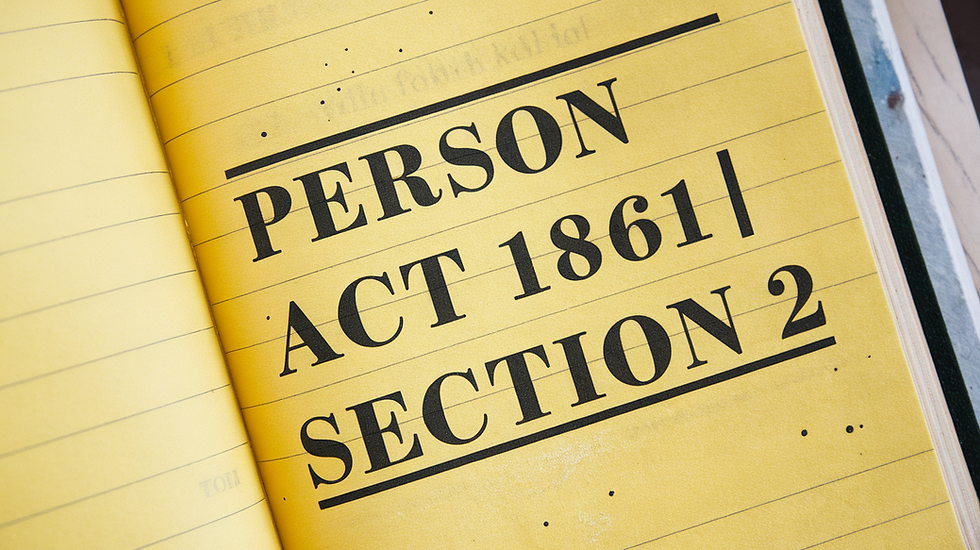Offences Against the Person Act 1861 | Section 2
- WLD Team

- 2 days ago
- 4 min read
The Offences Against the Person Act 1861 (OAPA 1861) remains one of the cornerstones of criminal law in England and Wales. It consolidates many earlier statutes on violence and personal injury.
After Section 1 clarifies that the Act does not cover murder, Section 2 deals directly with manslaughter. Manslaughter is one of the most serious offences in criminal law, second only to murder.
Section 2 does not redefine manslaughter but confirms its legal treatment and punishment. This provision was vital for ensuring clarity in homicide law during the 19th century and continues to influence modern interpretations.

Offences Against the Person Act 1861 Section 2 – The Text
Section 2 of the Offences Against the Person Act 1861 states:
“Whosoever shall be convicted of manslaughter shall be liable, at the discretion of the court, to be kept in penal servitude for life, or for any term not less than three years,—or to be imprisoned for any term not exceeding two years, with or without hard labour,—and whosoever shall be convicted of the crime of being an accessory after the fact to manslaughter shall be liable, at the discretion of the court, to be kept in penal servitude for any term not exceeding seven years, or to be imprisoned for any term not exceeding two years, with or without hard labour.”
Breaking this down:
Conviction for manslaughter: Carries punishment ranging up to life penal servitude (later interpreted as life imprisonment).
Court discretion: Judges may impose lighter or heavier penalties depending on the circumstances.
Accessory after the fact: Anyone assisting a person guilty of manslaughter after the offence can also face severe punishment, up to seven years.
Offences Against the Person Act 1861 Section 2 – Importance
Section 2 is significant for several reasons:
Defines punishment: It sets out the sentencing framework for manslaughter.
Judicial discretion: Unlike murder, which carried a mandatory death penalty at the time, manslaughter sentencing allowed flexibility.
Accessory liability: It ensures not only the offender but also those who help them afterward are punished.
Historical context: It shows how Victorian lawmakers treated homicide differently depending on intent and circumstances.
Without Section 2, there would have been uncertainty about how manslaughter should be punished under statute law.
Offences Against the Person Act 1861 Section 2 – Manslaughter Explained
Manslaughter differs from murder because it lacks the element of malice aforethought (the intention to kill or cause grievous bodily harm). It covers unlawful killings where intent is absent or circumstances reduce the offence from murder.
Types of manslaughter include:
Voluntary manslaughter: Where there is intent to kill but mitigating factors (e.g., provocation, diminished responsibility).
Involuntary manslaughter: Where death results from recklessness, negligence, or an unlawful act without intent to kill.
Section 2 provides the punishment for both forms, leaving the precise definitions to common law.
Offences Against the Person Act 1861 Section 2 – Sentencing Framework
At the time of enactment:
Life penal servitude: Equivalent to life imprisonment today.
Minimum term of three years: Ensured serious punishment for manslaughter convictions.
Imprisonment with hard labour: Reflected Victorian penal practices.
Accessory after the fact: Separate punishment to deter others from helping offenders escape justice.
Today, while hard labour no longer exists, the principle of judicial discretion remains in sentencing manslaughter cases.
Offences Against the Person Act 1861 Section 2 – Practical Example
Imagine two scenarios:
Voluntary Manslaughter: A person kills another in sudden anger after severe provocation. This is not murder because of the provocation but still unlawful killing. Section 2 provided the punishment framework.
Involuntary Manslaughter: A factory owner ignores safety rules, causing a worker’s death. The killing is unintentional but reckless. Section 2 ensures such negligence leads to serious punishment.
In both cases, the offender would face sentencing under Section 2, not under the provisions for murder.
Offences Against the Person Act 1861 Section 2 – Accessory After the Fact
Section 2 also punishes those who assist a manslaughter offender after the crime. Examples include:
Helping the offender escape.
Hiding the body or destroying evidence.
Providing shelter or false alibis.
By including this clause, Parliament ensured accountability extended beyond the main offender, discouraging others from aiding criminals.
Historical Context of Offences Against the Person Act 1861 Section 2
In 1861, homicide law was split between murder (punished by death) and manslaughter (punished by imprisonment). Section 2 was groundbreaking because:
It recognised manslaughter as serious but distinct from murder.
It gave courts flexibility, unlike the mandatory death penalty for murder.
It reflected evolving attitudes towards justice, mercy, and rehabilitation.
This approach influenced later reforms, including the Homicide Act 1957, which reshaped homicide law in England.
Conclusion
Section 2 of the Offences Against the Person Act 1861 is one of the most important provisions in criminal law history.
It established the sentencing framework for manslaughter, emphasised judicial discretion, and extended liability to accessories after the fact. While many legal reforms have since updated homicide law, the principles behind Section 2 remain relevant.
It shows how lawmakers balanced the seriousness of unlawful killing with the need for flexibility in punishment. Today, it stands as a historical foundation for the modern law of manslaughter.
FAQs
What does Section 2 of the Offences Against the Person Act 1861 say?
It sets the punishment for manslaughter, allowing life penal servitude or shorter prison terms, and punishes accessories after the fact with up to seven years’ penal servitude.
Why is Section 2 important?
It is important because it distinguishes manslaughter from murder, gives courts sentencing discretion, and ensures that even helpers of offenders are punished.
What is the difference between murder and manslaughter under Section 2?
Murder involves intent to kill or cause serious harm, while manslaughter covers unlawful killings without such intent or with mitigating circumstances.
How were accessories punished under Section 2?
Anyone convicted of being an accessory after manslaughter could face up to seven years of penal servitude or two years of imprisonment.
Is Section 2 still relevant today?
While sentencing rules have been modernised, Section 2 remains historically significant as the foundation for how manslaughter is treated in UK law.

Comments